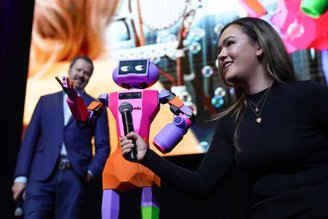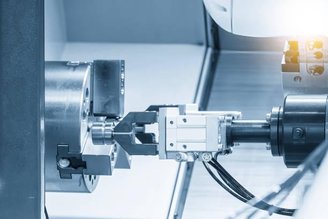Have you ever heard of collaborative robotics? This marks a new phase in automation: the development of robotic partners that work side by side with the company’s employees.
Designed to work with people, Cobots take on the following mission: increase productivity in certain industrial processes – without leaving any risk of accidents. Moreover, they save human collaborators from having to perform very heavy or repetitive activities.
Next, we will explain what Cobots are and how they can contribute to organizations and industries. Follow!
What are Cobots or Collaborative Robots?
Essentially, Cobots are collaborative robots. In other words, ones designed to work alongside humans using automated tools.
The term first appeared in 1999 and is a combination of the words “collaboration” and “robot”. They are replacing robots used in industryand operated using large machines that had to remain in isolated locations to avoid putting workers at risk.
Therefore, Cobots appear as an evolution of these older robots, as they have sensors and devices that guarantee greater safety for those who work with these machines.
These robots stand out precisely for their collaboration features (they were developed to help humans) and automation (they have the ability to become extremely productive, performing automation tasks previously unimaginable for a robot).
They are generally most usedtasks that involve repetitive manual workMany things like assembly, screwing, welding, packaging and stock selection.
The idea is that, in addition to increasing the productivity of the company, it also serves to increase the well-being of its team of employees, who will have extra help and no longer have to perform tasks that require a lot of repetitive physical effort.
How do Collaborative Robots work?
By definition, Collaborative Robots are designed to be able to act collaboratively with humans in a production environment such as industry.
Unlike traditional robots, they can interact with employees in their workplaces and are ready to act without creating the risk of accidents.
This is happening because they They are equipped with sensors and security systems that allow them to detect the presence of people. These features include specific functions such as:
- A type of internal monitoring that allows the robot to stop working when it touches a person or machine;
- The presence of force and torque sensors in the joints that can detect non-standard collisions;
- The presence of cameras and proximity sensors that can map the work environment and interact with it safely.

Collaborative Robots can be programmed to perform tasks such as handling materials, assembling products, sorting items, painting parts, and much more.
They can also be equipped with: machine learning and artificial intelligence (AI), which enables them to continuously learn and adjust their actions to the needs presented by the production system.
In this way, they are fully prepared to work alongside human workers, serving to increase efficiency and safety within a company.
What are the differences between traditional robots and Cobots?
As we have seen before, Cobots appear as an evolution of traditional robots. But there are some striking differences between them. The most obvious of these is this: Cobots were developed to share the workspace with humans.
On the other hand, traditional robots had to be isolated so that they did not pose a risk to professionals. This becomes clear when we consider certain sectors, such as the automobile industry, where robots must be placed in closed warehouses to perform car assembly tasks.
On the other hand, Collaborative robots were designed from the beginning to improve human workand does not replace it. They typically perform tasks with greater precision and precision.
The interesting thing about cobots is that they can also be used as traditional robots, making the most of their production capacity but still remaining close to humans.
An example of this is a robotic arm moving over part of a part assembly. It is then equipped with sensors that detect when an employee comes within range. If so, reduce your speed to avoid risking an accident at work.
Types of Collaborative Robots
In general terms, we can divide Cobots into some groups:
Collaborative mobile robots (AMR)
These refer to autonomous robots that move using built-in scanners and cameras. They do not need a magnetic strip to move like AGVs (Autonomous Guided Vehicle). Therefore, AMRs are more autonomous and easier to program.
Collaborative weapons
As the name suggests, they are compact robots that can be used safely with the team, as if they were arms. They are often used to perform dangerous or highly repetitive tasks.

Collaborative Robots communicating with other peripheral equipment
These are robots that share tasks with other Cobots, external equipment and peripherals involved in the same production process.
Robots Collaborative with Workers
These robots are designed to offer complete security to a company’s employees. They can rely on alert systems such as lights that indicate the Cobot has completed its task so the worker can continue the process.
When should you use Cobot in your operation?
Cobots can be of great help to various types of companies that have tasks in their production systems that can be automated, minimizing time and freeing up workers for more strategic functions. Thus, it is possible for them to add new machines to your business, replace old machines and even start new processes.
It should be noted that this is an expanding field where new technologies and applications are constantly being developed. For this reason, Cobots tend to evolve permanentlyWe bring our options to companies working with some form of industrial automation.

Since cobots have the ability to work in collaboration with humans, they provide flexibility and convenience in their performance by adding to the work done by the team rather than replacing it.
What are the advantages of using Collaborative Robot?
A company with a Collaborative Robot can count on many advantages. Let’s see what they are below.
Reduced operating costs
Cobots add greater efficiency to production as they perform complex and repetitive tasks quickly and with a low probability of error. This allows employees to focus on more complex tasks.
task automation
Manual work can be done Automated with Collaborative Robot. Some steps can even become more precise thanks to the assertiveness of the machines.
It is worth remembering that this implementation is not only faster, but also quite ambitious, as a robot tends to move much more precisely than humans.
Continuous operation
Cobots can operate 24 hours a day and autonomously. Human workers can perform maintenance as well as trust in their work.
Reducing occupational risks
As human employees focus on complex and technical tasks within the company, Less risk of occupational diseases such as RSI (Repetitive Strain Injury). These repetitive activities are now performed by Cobots, improving employee well-being.
The same goes for tasks that require carrying heavy items that could damage workers’ spines.
competitive advantage
Since cobots increase the efficiency of the company, it can revise production costs, charge more attractive prices in the market and differentiate itself from competing companies.
Did you like this content? Keep coming to TecMundo to check the most complete information about the world of technology. Until next time!
Source: Tec Mundo
I am a passionate and hardworking journalist with an eye for detail. I specialize in the field of news reporting, and have been writing for Gadget Onus, a renowned online news site, since 2019. As the author of their Hot News section, I’m proud to be at the forefront of today’s headlines and current affairs.











